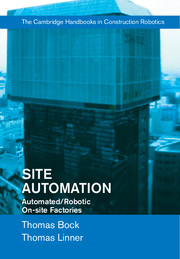Book contents
- Frontmatter
- Contents
- Acknowledgements
- Glossary
- 1 Integrated Automated/Robotic On-site Factories
- 2 Analysis and Categorization: Construction pages 8 to 144
- 2 Analysis and Categorization: Construction pages 145 to 256
- 3 Analysis and Categorization: Deconstruction
- 4 Conclusion: Discrepancy between Technical Capability and Efficiency
- References
- Index
4 - Conclusion: Discrepancy between Technical Capability and Efficiency
Published online by Cambridge University Press: 05 April 2016
- Frontmatter
- Contents
- Acknowledgements
- Glossary
- 1 Integrated Automated/Robotic On-site Factories
- 2 Analysis and Categorization: Construction pages 8 to 144
- 2 Analysis and Categorization: Construction pages 145 to 256
- 3 Analysis and Categorization: Deconstruction
- 4 Conclusion: Discrepancy between Technical Capability and Efficiency
- References
- Index
Summary
The analyses of automated/robotic on-site factories deployed so far reveal an interesting discrepancy between the technical performance achieved (potential capability of overall systems or individual subsystems) and the improvements in productivity, economic performance, and efficiency achieved. Whereas from a technical viewpoint the developed and deployed technologies (e.g., in terms of modularity, flexibility, variability, robot-oriented design [ROD]) have reached an outstanding level, efficiency, productivity, and economic performance stayed still behind the achievements in other comparable industries.
The conducted analyses claim to have identified and analysed all approaches to automated/robotic on-site factories that were conducted so far. Considering the analysed systems, and the fact that some of the systems were used several times (e.g., ABCS and SMART each up to 10 times), that subsystem applications are frequently used (e.g., Obayashi), and that currently the application of the on-site factory approach for deconstruction is taking off in Japan, it can be said that the automated/robotic on-site factory approach up to today was applied more than 60 times worldwide.
On the basis of the technical analysis (analysis of technical aspects, configuration of systems, etc.), the categorization into 13 categories shows that automated/robotic on-site factories can be installed at various locations on the construction site (on the ground, on top of buildings) and can progress in various directions (e.g., vertically upwards or horizontally), thus allowing solutions for almost any building typology (e.g., various high-rise building typologies, condominiums, point block buildings, steel buildings, concrete buildings, see Chapter 2, Sections 2.1 to 2.10). Besides construction purposes, the on-site factory approach can also be used to deconstruct buildings of different typologies (see Chapter 3, Sections 3.1 to 3.3). This means from a technical point of view, that automated/robotic on-site factories, on the basis of the applied and analysed technologies (subsystems, end-effectors, factory layouts), hold the potential to be developed for manufacturing any vertically or horizontally oriented building typology.
The analysis of subsystems and end-effector technology showed that automated/robotic on-site factories were in most cases developed as modular kits that allowed through a combination of inbuilt flexibility and modular flexibility for high variability. Each system could be broken down into multiple subsystems (see analysis of subsystems for each system in Chapters 2 and 3). Systems that work besides a main factory (e.g., sky factory [SF]) with a sub-factory (ground factory) are composed of up to 12 subsystems.
- Type
- Chapter
- Information
- Site AutomationAutomated/Robotic On-Site Factories, pp. 299 - 304Publisher: Cambridge University PressPrint publication year: 2016



